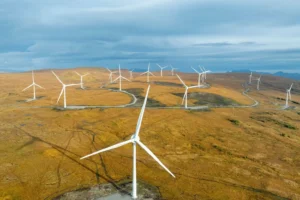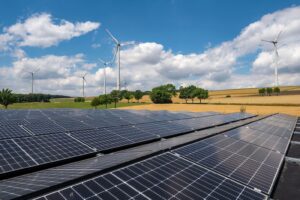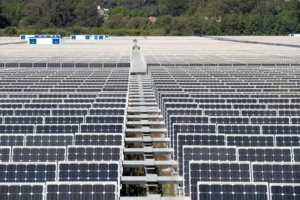We handpick and explain the most important stories at the intersection of climate, land, food and nature over the past fortnight.
This is an online version of Carbon Brief’s fortnightly Cropped email newsletter. Subscribe for free here.
Key developments
UN food insecurity report
HUNGER DECLINES: The prevalence of hunger dropped in most parts of the world in 2024, according to a new report covered by Carbon Brief – but rates are still rising in much of Africa and western Asia. The UN’s annual report on food security and nutrition found that around 673 million people experienced hunger in 2024. Other key findings were that the cost of a “healthy” diet increased in 2023 and 2024 and that food price inflation “significantly” outpaced general inflation over the past five years. The price inflation was mostly driven by global factors, but also by localised shocks such as “climate extremes” disrupting food production, the report said.
‘UNEVEN’ PROGRESS: Global progress on tackling hunger is “encouraging”, but “uneven”, the director-general of the UN Food and Agriculture Organization, Dr Qu Dongyu, said in a statement. The new report found that the entire population in Gaza faced “high levels of acute food insecurity” in 2024, alongside more than half of people in Sudan, South Sudan, Yemen and Haiti. Elsewhere, the UN World Food Programme said that hunger levels in Gaza are “catastrophic”, while Reuters reported warnings from a global hunger monitor that a “worst-case scenario of famine is unfolding” there. UN chief António Guterres told the UN Food Systems Summit Stocktake this week in Ethiopia: “We must never accept hunger as a weapon of war.”
‘CLIMATEFLATION’: Elsewhere, a thinktank report said the UK faces “climateflation” impacts that could “drive up food prices by more than a third by 2050”, the Guardian said. The Autonomy Institute said that “increasing numbers of heatwaves and droughts would imperil staple crops, disrupt supply chains and intensify inflationary pressures”, the outlet added. UK food price inflation increased in July for the sixth consecutive month, partly driven by “rising meat and tea prices”, BBC News reported. Carbon Brief mapped out the findings of a new study showing links between extreme weather and food price spikes around the world.
Africa’s clean-cooking and nature goals
‘UNREACHABLE GOAL’: Sub-Saharan Africa will not reach the UN 2030 goal of providing clean cooking for all, according to a report from the International Energy Agency (IEA). “Large gaps” in financing and infrastructure mean universal access by 2040 is “more realistic”, it continued. The number of Africans without access to clean cooking “has continued to grow” and is currently around 1 billion people, Climate Home News reported. The report stated that $37bn in investment is required to achieve universal access. In a statement, IEA’s executive director, Fatih Birol, said that lack of clean cooking “remains one of the great injustices in the world”.
-
Sign up to Carbon Brief’s free “Cropped” email newsletter. A fortnightly digest of food, land and nature news and views. Sent to your inbox every other Wednesday.
WILDLIFE BONDS: The Global Environment Facility (GEF) has planned a new wave of wildlife conservation bonds to provide up to $1.5bn to “help African countries” save endangered species and ecosystems, Reuters reported. The GEF’s head of programming told the newswire that the bonds, which provide low-cost funding in return for curbing poaching or other conservation measures, will be issued for every country in Africa. The bonds will help poorer countries receive funding without adding to government debt. While such bonds usually target “emblematic” species, the GEF hopes to use the bonds to cover entire ecosystems, such as wetlands, Reuters said.
CONGO’S BIOFUELS: Italian oil company Eni has closed one biofuels pilot project in the Republic of Congo, but two other such projects remain in an experimental phase, InfoNile reported. Eni previously signed a 50-year agreement with the Congolese government to develop the country’s agro-biofuel sector, with a plan to cover 150,000 hectares of agricultural land by 2030. However, local farmer Chris Nsimba told InfoNile that, although Eni has brought economic development to his district, the company has made “little contribution” to local food security.
‘DRAMATIC EXPANSION’: Tenders for oil development are now available across “more than half” of the Democratic Republic of the Congo, a new report from Earth Insight and other groups found. The government recently launched a licensing round for 55 oil blocks, the report said – a “dramatic expansion” which poses “major threats” to forests and protected areas. The oil blocks overlap with 8.6m hectares of “key biodiversity areas” and 66.8m hectares of intact tropical forests. This decision highlights “stark contradictions between the DRC’s fossil-fuel agenda and its stated commitments to biodiversity protection, climate action and community rights”, the report said.
Spotlight
‘Unprecedented’ marine heatwaves gripped the globe in 2023
This week, Carbon Brief covers a new study, published in Science, which found that 96% of the global ocean experienced a marine heatwave during 2023.
More than 95% of the world’s expanse of oceans experienced a marine heatwave – a period of abnormal ocean warming lasting at least five days – in 2023, according to new research.
The study, published in Science, used an ocean model that incorporates satellite and observational data to identify marine heatwave events and investigate the drivers of the unusual ocean heating.
It found that 2023 was an “unprecedented” year for marine heatwaves in terms of duration, extent and intensity of the events.
Many of the events had “immediate ecological and societal consequences”, the authors wrote.
‘Comprehensive investigation’
In 2023, marine heatwaves bleached corals in the Florida Keys, boosted the prevalence of a giant-clam-killing parasite in the Mediterranean and even intensified heatwaves on land during Europe’s “hellish” summer that year.
Using satellite data and an ocean model that incorporates different streams of data, the team of researchers “conducted a comprehensive investigation” of the global ocean’s state in 2023, they wrote. Together, the authors wrote, that year’s marine heatwaves had the “longest durations, widest extents and highest intensities on record”.
They found that the average duration of marine heatwaves in 2023 was 120 days, compared to an average duration of just under 36 days between 1982-2022. Spatially, the 2023 heatwaves covered 96% of the global ocean, compared to a historical average extent of around 74%.
Prof Regina Rodrigues, a physical oceanographer at Brazil’s Universidade Federal de Santa Catarina, told Carbon Brief that, while the science underlying the study is “sound”, the study itself “does not bring many new aspects”. Rodrigues, who was not involved in the new research, added:
“The results are not different from those of many previous studies, except for the analysis of these regions together and for the same year.”
Driving factors
The researchers identified four main “hotspots” of the ocean that had the highest marine heatwave “cumulative intensity”: the tropical eastern Pacific, the south-west Pacific, the north Pacific and the north Atlantic. (Cumulative intensity is a metric that accounts for both intensity and duration of a heatwave.)
The researchers then used the ocean model to investigate the underlying drivers of marine heatwaves in each hotspot.
For example, in the north Pacific, they found that a combination of low cloud cover – allowing more sunlight to reach and warm the ocean’s surface – and weak winds resulted in around 1C of average warming throughout the year. A lack of cloud cover also contributed significantly to the heatwaves in the north Atlantic and south-west Pacific, they wrote.
It is “no surprise at all” to find that marine heatwaves have increased in frequency, intensity, duration and extent, “given that the ocean absorbs 90% of the heat from manmade climate change”, Rodrigues told Carbon Brief.
She pointed to a Nature study published earlier this year that examined the global record sea-surface temperatures of 2023-24. That study concluded:
“Without a global warming trend, such an event would have been practically impossible.”
News and views
WETLANDS SUMMIT: More than 3,000 delegates met in Zimbabwe for the 15th conference of the Ramsar Convention (COP15) to discuss the future of the world’s wetlands. Opening the event, Zimbabwe’s president, Emmerson Mnangagwa, called for the implementation of “collaborative approaches” towards wetlands protection, Down To Earth reported. Several southern African countries officially launched the Southern Africa Ramsar Regional Initiative to promote wetland conservation and sustainable use across borders, EnviroNews Nigeria reported. Additionally, China Daily reported that nine more Chinese locations were awarded “wetland city accreditation” at the conference, which concludes this Thursday.
‘DEVASTATION BILL’: Politicians in Brazil approved a bill to ease environmental licensing, a move criticised as the country’s “most significant environmental setback in nearly 40 years”, Mongabay said. The so-called “devastation bill” includes rule changes which would allow projects to be approved “by simply filling out an online form”, the outlet reported. It would also create a “special environmental licence” for “strategic” projects, “such as oil exploration on the Amazon coast”. Mongabay noted that President Luiz Inácio Lula da Silva can block or enact the bill, but “congress would likely overturn a veto”. It added: ”The law is bound to be challenged in the Supreme Court.”
SEABED STRIFE: Members of the International Seabed Authority (ISA) condemned the move earlier this year by a deep-sea mining company to “bypass the authority’s protocols by applying for a permit to mine in international waters under US law”, Inside Climate News reported. Oceanographic said that the ISA has “launched an official investigation” into contracting companies “over action taken to circumvent” existing protocols. The outlet said the decision was a “critical step in protecting the deep sea”. However, delegates at the recently concluded ISA meeting once again “failed” to reach an agreement on whether or not to allow seabed mining to proceed in international waters, reported Common Dreams.
FARMER FUNDS: The EU’s new long-term budget proposal featured cuts to agricultural spending, but the European Commission “insists” farmers will not be impacted, Euronews reported. The proposal outlined plans to combine agricultural subsidies and regional development funds into one “mega-fund worth €865bn”, the outlet said. Politico reported that the proposed changes mean “biodiversity goals have no earmarked funding at all – and will have to compete with the EU’s other environmental aims, including climate change, water security, the circular economy and pollution”.
‘TOXIC’ ALGAE: A toxic algal bloom along South Australia’s coastline has shown “no sign of abating” four months in, after killing sharks, rays, fish, dolphins and seals, the Sydney Morning Herald reported. The algae grew and spread due to a marine heatwave in September 2024, which caused ocean temperatures to be 2.5C warmer than usual. Marine ecologist Dr Scott Bennet told CNN: “This is symptomatic of climate-driven impacts that we’re seeing across Australia due to climate change.” Meanwhile, Reuters reported on a “revolution” in farm management that has boosted Australia’s wheat production “despite hotter, drier conditions”.
Watch, read, listen
CLOUD COVER: The New York Times profiled the scientists attempting to save the Great Barrier Reef by increasing cloud cover to cool the Pacific Ocean.
SYCAMORE SENTENCE: In Bloomberg, Josie Glausiusz argued that prosecuting the men who felled the Sycamore Gap tree in northern England in 2023 “mean[s] little” without stronger action to protect the natural world.
DECLINING SUPPLY: The Guardian visualised how Donald Trump’s “assault” on immigrants in the US could affect the country’s food supplies.
AN ICONIC TREE: Mongabay explored whether the Joshua Tree – a yucca plant native to the south-western US – can survive in the face of increasing drought, fires and development.
New science
- A Nature Communications study found that lands managed by Afro-descendant communities in Brazil, Colombia, Ecuador and Suriname experience up to 55% less deforestation than lands managed by others. The study highlighted the adaptation of African knowledge, the authors said, calling for a greater inclusion of Afro-descendants in environmental decision-making.
- Fewer than 10% of predicted “hotspots” of a type of fungi around the world are currently contained in protected areas, according to a Nature study. The findings can benefit conservation, monitoring and restoration of the “largely hidden component of Earth’s underground ecosystems”, the study authors wrote.
- New research, published in Science Advances, found that the prioritisation of creating “biodiversity-friendly landscapes” through conservation activities may actually accelerate biodiversity loss by improving conditions for invasive alien species. The authors called for a “shift” towards “landscape-wide strategies to stop the ongoing decline of farmland biodiversity”.
In the diary
- 5-14 August: Fifth session of the Intergovernmental Negotiating Committee on plastic pollution (part two) | Geneva
- 9 August: UN international day of the world’s Indigenous peoples
- 13-15 August: African Union-AIP water investment summit 2025 | Cape Town, South Africa
Cropped is researched and written by Dr Giuliana Viglione, Aruna Chandrasekhar, Daisy Dunne, Orla Dwyer and Yanine Quiroz. Svetlana Onye also contributed to this issue. Please send tips and feedback to cropped@carbonbrief.org
The post Cropped 30 July 2025: ‘Unprecedented’ ocean heatwaves; ‘Uneven’ hunger progress; Brazil’s ‘devastation bill’ appeared first on Carbon Brief.
Greenhouse Gases
DeBriefed 1 August 2025: Trump targets ‘endangerment finding’; Floods and heatwaves; ‘Thirst’ exhibition
Welcome to Carbon Brief’s DeBriefed.
An essential guide to the week’s key developments relating to climate change.
This week
Trump to overturn ‘endangerment finding’
EPA OVERTURNING: The Trump administration announced its plan to overturn the 2009 finding that has been the “central basis” for US action to regulate greenhouse gas emissions, the Associated Press reported. A new Environmental Protection Agency proposal would rescind the “endangerment finding”, which determined that carbon dioxide and other greenhouse gases endanger public health and welfare, according to the newswire. If the finding is repealed, it would “erase current limits” on greenhouse gas pollution from cars, factories and power plants, AP said.
‘MISLEADING’ REPORT: The proposal is supported by a new Department of Energy report that uses “misleading and inaccurate” statements to argue that climate science has “overstated” the risks of a warming planet, Politico reported. The report, which also argues that climate science is “underestimating” the societal benefits of burning fossil fuels, was written by five scientists who “are known” for “denying accepted climate science”, the outlet added.
‘WINDMILL DISGRACE’: Wind development on federal lands and waters may be halted by the Trump administration, Bloomberg reported. Interior secretary Doug Burgum ordered a comprehensive review of the agency’s approval process, it said. According to Renewable Energy News, the department said more than 3.5m acres offshore were designated as “wind energy areas” by the last administration and that “terminating” these areas is “safeguarding” local environments and economies from “unchecked development”. This followed from Trump’s recent comment that “windmills are a disgrace”, the publication added.
Floods and heatwaves
SEVERE FLOODING: Torrential rains triggered a devastating flood in northern Nigeria, leaving at least 23 people dead, Deutsche Welle reported. The flooding has displaced 5,560 people and left dozens injured, according to the National Emergency Management Agency. More than 200 people have been killed in floods in Nigeria since the start of the rainy season in May this year, according to DW. The outlet reported that scientists have said climate change is fuelling many of these extreme weather occurrences.
BEIJING RAINS: China faced “another deadly rainy season” after 60 people were killed following days of torrential rain in Northern Beijing, reported Reuters. The outlet said climate change has made extreme weather “more frequent and intense”. Elsewhere, floodwaters from the Indus and Chenab rivers have “inundated” more than a dozen villages across Pakistan’s Punjab province, said India’s Tribune.
RECORD TEMPERATURE: Japan recorded its hottest day on record as temperatures reached 41.2C in southwest Tokyo, Al Jazeera reported. There were 16 heat-related deaths and more than 10,800 people were hospitalised with heatstroke last week, the outlet said. Meanwhile, the Iraqi government issued an official holiday in seven of its provinces as temperatures topped 50C, said Gulf News.
‘MILLIONS’ INSIDE: Temperatures soaring in the US have led to “millions” of Americans being warned to stay inside as some areas reach 48.8C, noted Newsweek. Heat warnings and advisories have been issued by the National Weather Service, according to the outlet.
Around the world
- ENERGY PLEDGE: The European Union has pledged to buy $750bn of energy from the US in exchange for a lower tariff rate under its trade deal with Trump. “Significant purchases” of US oil, liquified natural gas and nuclear fuel to replace Russian fossil fuels are included in the deal, CNBC reported. The Financial Times quoted energy experts saying the deal is a “pie in the sky” given that “US fossil fuel supplies [in 2024] to the bloc accounted for just $75bn”.
- COP30 COSTS: The UN held an “urgent meeting” over “sky-high” accommodation costs ahead of the COP30 climate summit in Brazil, Reuters reported. Meanwhile, the last US climate negotiators have been fired by the Trump administration, leaving the nation with “no official presence” at the summit, said CNN.
- ‘MELTING RAPIDLY’: Glaciers in Turkey’s southeast are melting rapidly due to rising global temperatures “amid human-caused climate change”, Al Jazeera reported.
- ‘SEWAGE CRISIS’: The US and Mexico have signed a deal to end the Tijuana “sewage crisis”, committing to update outdated wastewater infrastructure to handle higher flows triggered by worse flooding, said Inside Climate News.
- RENEWABLE ENERGY: Australia’s government has pledged to “substantially increase” its renewable energy underwriting scheme following concerns the nation will struggle to meet its 2030 power target, noted the Guardian. Meanwhile, New Zealand’s government has voted to resume gas and oil drilling despite an “outcry” from the opposition and environmental groups, reported the New Zealand Herald.
- ‘UNHELPFUL TUSSEL’: UN climate chief Simon Stiell paid a visit to Australia and urged the nation and Turkey to resolve their “long-running tussle” over who will host the COP31 summit, calling the delay “unhelpful and unnecessary”, Reuters reported.
66.8 million
The hectares of intact tropical forest that overlaps with oil blocks in the Democratic Republic of Congo, according to Earth Insight.
Latest climate research
- Climate change could make ‘droughts’ for wind power 15% longer | Carbon Brief
- A study of urban construction workers in Taiwan found that heat stress imposes “substantial economic burden” and results in productivity losses in the range of 29-41% | Nature Cities
- Drought will increasingly contribute to the collapse of many bird species that live in highly arid regions of the US | Biological Conservation
(For more, see Carbon Brief’s in-depth daily summaries of the top climate news stories on Monday, Tuesday, Wednesday, Thursday and Friday.)
Captured
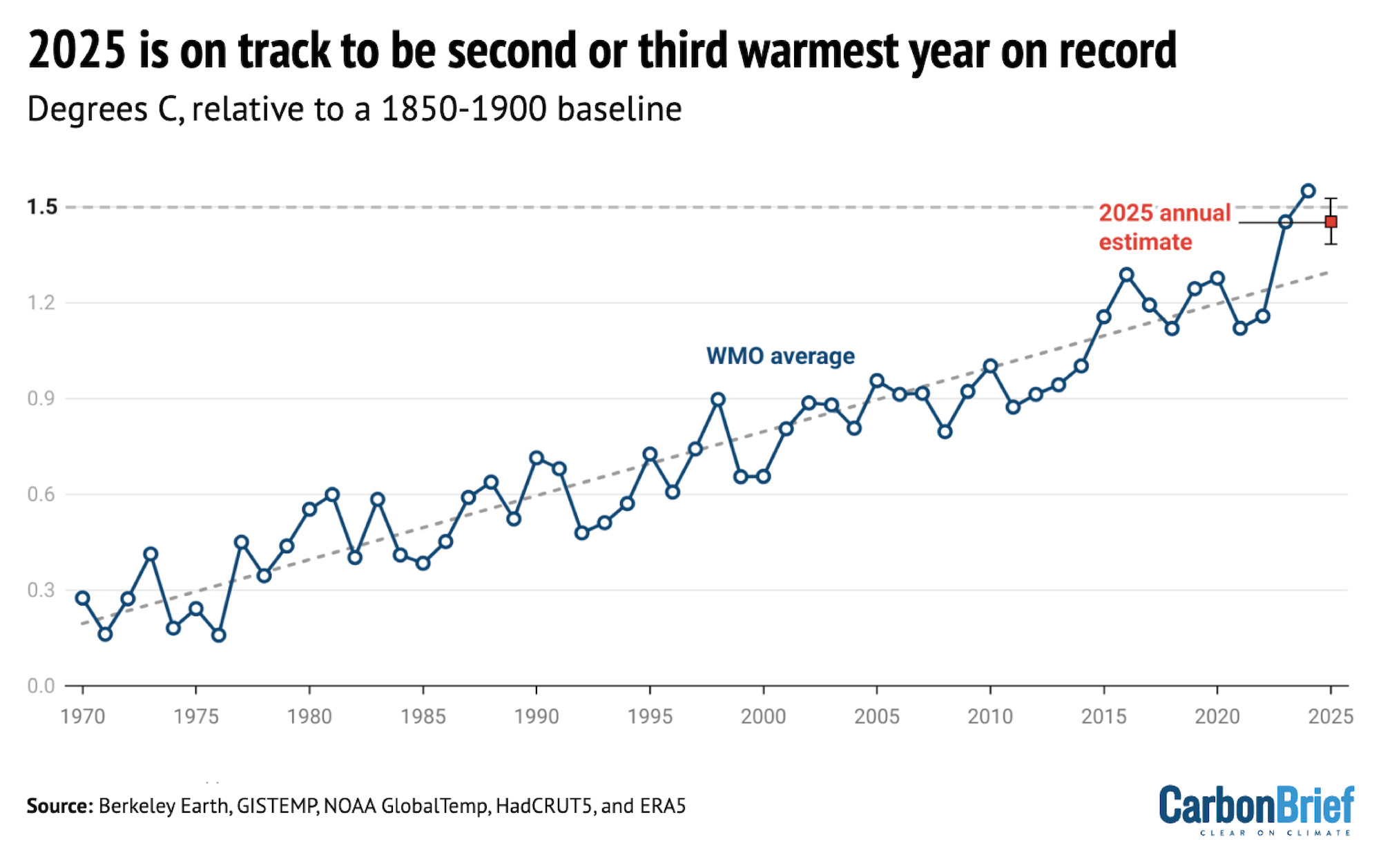
New analysis by Carbon Brief this week revealed that 2025 is on track to be the second or third hottest year on record. The chart above draws on data from five different research groups that report global surface temperature records to illustrate how 2025 saw the second-hottest first half of the year on record.
Spotlight
‘Thirst’ exhibition maps the water crisis
This week, Carbon Brief visits a London exhibition exploring the world’s worsening water crisis.
Intricate ink drawings on cotton paper explore interconnected issues in Nepal.
Global warming has melted glaciers in the region, causing flooding and infectious diseases, displacing human and non-human life.
Yet, through his drawings, Nepalese artist Karan Shrestha has created a mosaic of the Himalayan region that shows water as a signifier of extreme weather and a life-giving source to be shared.

His piece, “Water-giver, memory-keeper and the shifting forces”, is displayed at the Wellcome Collection for its “Thirst: In Search of Freshwater” exhibition.
Brought together by Wellcome curator and lecturer Janice Li, it features 125 objects that showcase the impact of climate change on water and its role in shaping health and ecosystems.
Li’s research into the etymology of “thirst” unravelled a global interpretation of water, reflecting the exhibition’s geographical breadth. She told Carbon Brief:
“Humans have faced really brutal and critical environmental crises and have, through a really deep innate knowledge of their own specific land, been able to devise monumental infrastructure to combat the crises they face.”
Just before Shrestha’s art in the exhibition are photographs taken by M’hammed Kilito.
In one picture, Kilito’s guide, Mustapha, looks into a dried-up well in a Moroccan oasis.
Climate change and human activities have resulted in the loss of two-thirds of oases in the country, according to information displayed at the exhibition.
Speaking about the photograph, Kilito told the Guardian that it looked like Mustapha was “praying for the return of something essential: water”.
Water adopts multiple faces in the exhibition: a vital yet scarce resource in certain pieces, a spiritual entity in others – and a destructive force.
Nothing makes the latter as clear as “Deluge” by photojournalist Gideon Mendel. Five screens display footage of the aftermath of severe floods around the world, captured by Mendel over 17 years.

Li told Carbon Brief:
“[Gideon] told me that, in the last two years, there’s always been a flood of that magnitude happening somewhere. He didn’t imagine that one day it would get to a point where he would have to choose which one to go to.”
Next to “Deluge” is a dome-like space where visitors can sit on bean bags and listen to glaciers melting in the Himalayas.
Though the exhibition confronts global water challenges, Li hopes it also reminds visitors of the resource’s beauty:
“Quite a few people told me they sit in the listening room for half an hour, really enjoying themselves and then guilt hits them because they’ve forgotten they’re listening to melting ice. But, this is the beauty of art, and a lot of beauty has come out of decay, destruction and deterioration because it also, sometimes, signals rebirth.”
Watch, read, listen
YAK HERDERS STRUGGLE: The Associated Press featured the stories of yak herders in India’s Himalayan mountains as climate change threatens their way of life.
PILOT ANXIETY: A Guardian documentary followed two airline pilots grappling with the climate impacts of their jobs.
‘IS DECARBONISATION DEAD?’: New York Times columnist Ezra Klein invited climate experts onto his podcast to discuss the future of renewable energy in the US.
Coming up
- 5-14 August: Second part of the fifth session of the Intergovernmental Negotiating Committee to Develop an International Legally Binding Instrument on Plastic Pollution, Geneva, Switzerland
- 9 August: UN international day of the world’s Indigenous peoples
- 11-15 August:UN Environment Programme’s International Methane Earth Observatory at AmeriGeo Week 2015: Earth Observations for the Americas, Bogotá, Colombia
Pick of the jobs
- Climate Justice Standard Lab, research associate in forest carbon and climate justice | Salary: $25-35 an hour. Location: Remote
- The Church of England, net-zero carbon programme decarbonising churches lead | £59,248. Location: Remote
- UN Office for Project Services, country engagement specialist and regional coordinator for eastern europe, Santiago network | Salary: Unknown. Location: Geneva, Switzerland
DeBriefed is edited by Daisy Dunne. Please send any tips or feedback to debriefed@carbonbrief.org.
This is an online version of Carbon Brief’s weekly DeBriefed email newsletter. Subscribe for free here.
The post DeBriefed 1 August 2025: Trump targets ‘endangerment finding’; Floods and heatwaves; ‘Thirst’ exhibition appeared first on Carbon Brief.
Greenhouse Gases
IEA: Renewables will be world’s top power source ‘by 2026’
Renewable energy will overtake coal to become the world’s top source of electricity “by 2026 at the latest”, according to new forecasts from the International Energy Agency (IEA).
The rise of renewables is being driven by extremely rapid growth in wind and solar output, which topped 4,000 terawatt hours (TWh) in 2024 and will pass 6,000TWh by 2026.
Wind and solar are increasingly under attack from populist politicians on the right, such as US president Donald Trump and Reform in the UK.
Nevertheless, they will together meet more than 90% of the increase in global electricity demand out to 2026, the IEA says, while modest growth for hydro power will add to renewables’ rise.
With nuclear and gas also reaching record highs by 2026, coal-fired generation is set to decline – driven by falls in China and the EU – meaning that power-sector emissions will decline, too.
The chart below illustrates these profound shifts in the global electricity mix – in particular, the meteoric rise of renewables, driven by wind and solar.
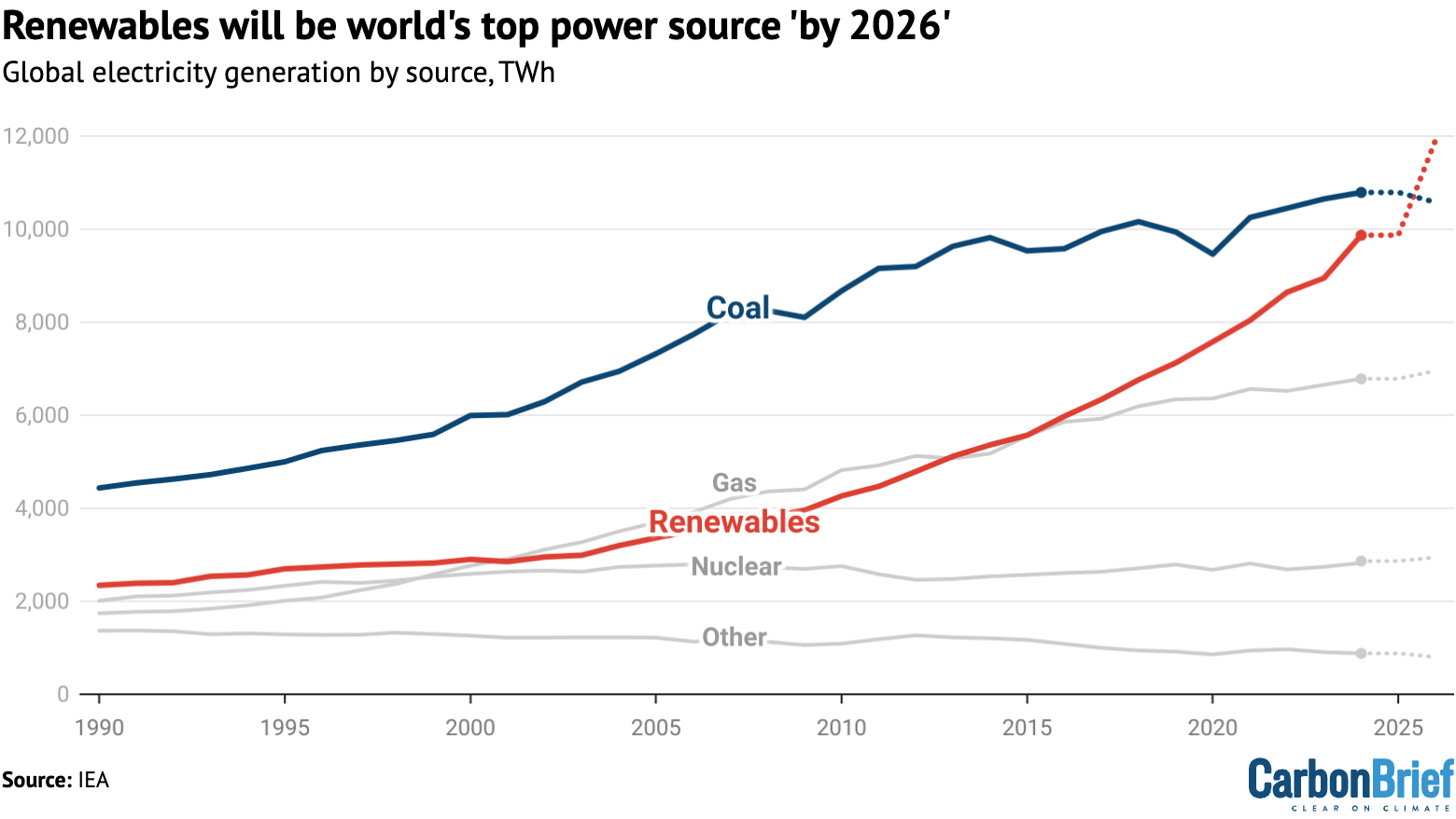
The IEA says that renewables could overtake coal as early as this year, depending on weather-related impacts on the output of wind and hydro capacity.
It adds that the switch will happen by 2026 “at the latest”, when renewables are expected to make up 36% of global power supplies, against just 32% from coal – the fuel’s lowest share in a century.
The share of global electricity generation coming from wind and solar combined will rise from 1% in 2005 and 4% in 2015 to 15% in 2024, 17% in 2025 and nearly 20% in 2026.
The global reduction in coal-fired electricity generation will result from declines in China and the EU, which will only be partially offset by increases in the US, India and other Asian nations.
The IEA attributes the coming decline of coal to “continued renewables growth and higher coal-to-gas switching in multiple regions”. It says gas power will rise by 1.3% this year and next.
For nuclear, the IEA says that the new record output will result from plant restarts in Japan, “robust” output in France and the US, as well as new reactors in China, India and South Korea.
The shift to wind and solar is happening despite global electricity demand being forecast to grow much faster over the next two years – at 3.3% and 3.7%, respectively – than the 2.6% average for 2015-2023.
The IEA says new demand is coming from industry, domestic appliances, growing use of air conditioning, ongoing electrification of heat and transport, as well as the expansion of data centres.
The post IEA: Renewables will be world’s top power source ‘by 2026’ appeared first on Carbon Brief.
Greenhouse Gases
Endangered angelshark faces ‘inhospitable’ breeding sites as ocean warms
“Unprecedented” ocean warming could make key habitats “inhospitable” for critically endangered angelsharks, according to new research.
The study, published in Global Change Biology, finds an “abnormal absence” of female sharks in a marine reserve near the Canary Islands throughout the 2022 breeding season.
This occurred during “unusually high” sea surface temperatures across the north-east Atlantic Ocean.
The study notes that the number of days with sea surface temperatures above 22.5C in the reserve nearly tripled over 2018-23.
This is significant, the authors say, because 22.5C is a “possible upper thermal threshold” for female angelsharks to tolerate.
The authors warn that ocean warming has “already altered” angelshark breeding behaviour, adding that the findings show that the species is “more acutely vulnerable” to climate change than previously thought.
Ocean warming
Angelsharks are flat-bodied, ray-like predators that can grow up to 2.4 metres in length.
They are typically found submerged in sandy habitats in the coastal waters of the north-east Atlantic Ocean and Mediterranean Sea.
They are listed as critically endangered on the International Union for Conservation of Nature’s (IUCN) red list of threatened species.
The authors note that the angelshark population has “declined substantially” due to “overexploitation” and “coastal habitat degradation”.
In the study, the researchers focus on the La Gaciosa Marine Reserve in the Canary Islands – Spain’s largest marine reserve.
The study notes that the Canary Islands are an “especially important region” for the angelshark and are at the “southernmost” boundary of the species’ distribution. As a result, angelshark populations around the islands have a “possibly lower tolerance for environmental change”, it states.
The researchers add that the north-east Atlantic Ocean is “undergoing rapid warming, characterised by exceptionally high temperatures and record-breaking marine heatwaves”.
As the climate continues to warm, extreme conditions are expected to occur more frequently and for longer, causing disruption to marine life.
The map below shows the historic and existing range of angelshark populations, as well as the locations of the acoustic receivers used to detect angelsharks in the study area.
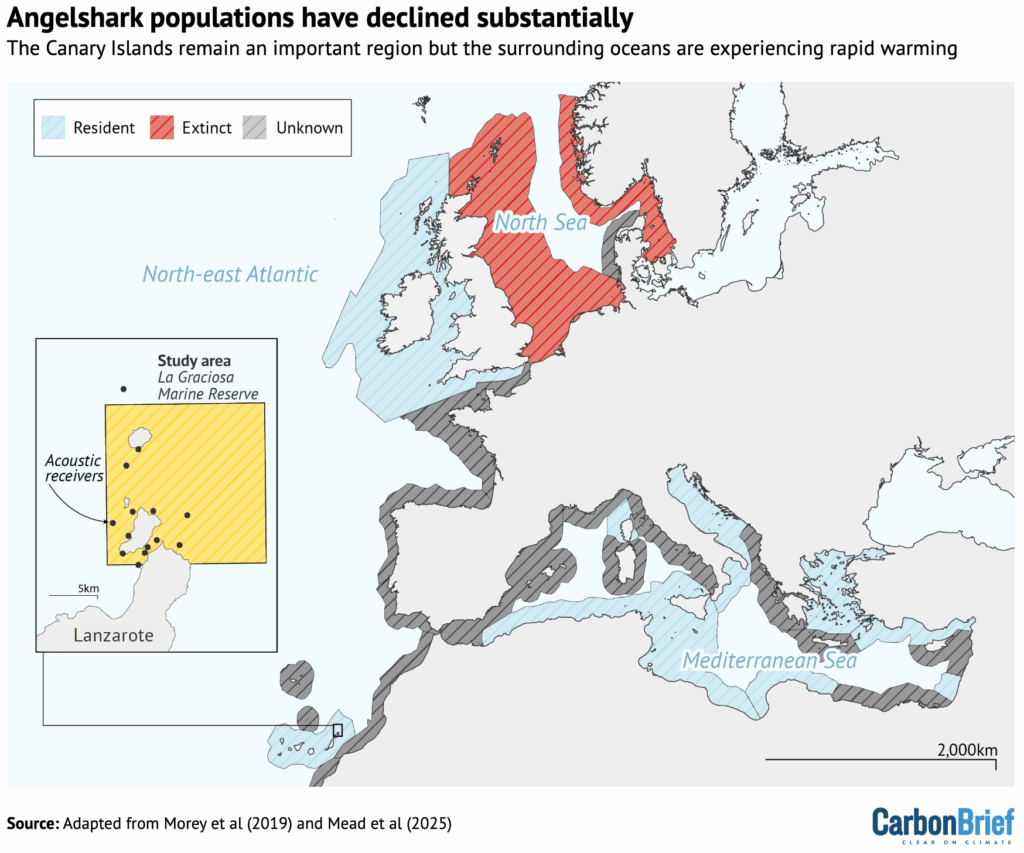
To explore how climate change in the region is impacting the angelsharks, the researchers focus on “range shift”.
Range shift is when a species migrates to either remain in ideal conditions or avoid sub-optimal environments, according to what they can withstand as the climate changes.
It is one of the most “pervasive” consequences of ocean warming, the study authors say.
Tracking angelsharks
To track the movements of angelsharks, the researchers tagged the fins of 112 animals – 38 males and 74 females – over 2018-22.
These “acoustic tags” emit sound that enabled the researchers to remotely track angelshark locations.
The researchers then used this acoustic data to investigate seasonal and annual changes to angelshark presence at the study site, taking into account the contrast between male and female behaviours.
The researchers also modelled changes to the environment over 2021-23 using a range of variables. These included sea surface temperature (SST), salinity, surface wind speed and SST anomaly – a measure of how temperatures differ from the long-term average.
They also looked at concentrations of chlorophyll a and dissolved oxygen, as well as two variables that act as an indicator for levels of desert dust in the air.
The latter were used to incorporate into their model the effect of Calima events – hot and dusty winds that reach the Canary Islands from the Sahara Desert, which raise overall air temperatures.
This “environmental model” allowed the authors to investigate the relationship between angelshark presence within the reserve and changing environmental conditions.
‘Marked absence’
Previous research has linked seasonal angelshark behaviours – such as movement and presence in a certain habitat – to the breeding cycle and, sometimes, environmental factors.
The new study finds that angelshark presence in the study area varies seasonally for both sexes, peaking in November and December. It notes an additional peak in June for female angelsharks, which were also more “consistently present” in the study area throughout the year than males.
Author Dr David Jacoby is a lecturer in zoology at Lancaster University. He explains to Carbon Brief:
“Females will often avoid males outside of the breeding season as mating is pretty violent and energy expensive in sharks. Females consequently are more likely to occur in shallow water [since] males [are more likely to be found] in deeper water.”
The charts below show the relative influence of different environmental variables on predicting male and female shark presence in the study area.
The chart on the left shows how the day of the year has the biggest influence on male angelshark presence, followed by salinity. The chart on the right shows that for female angelsharks, SST – followed by SST anomaly – was the most significant predictor.
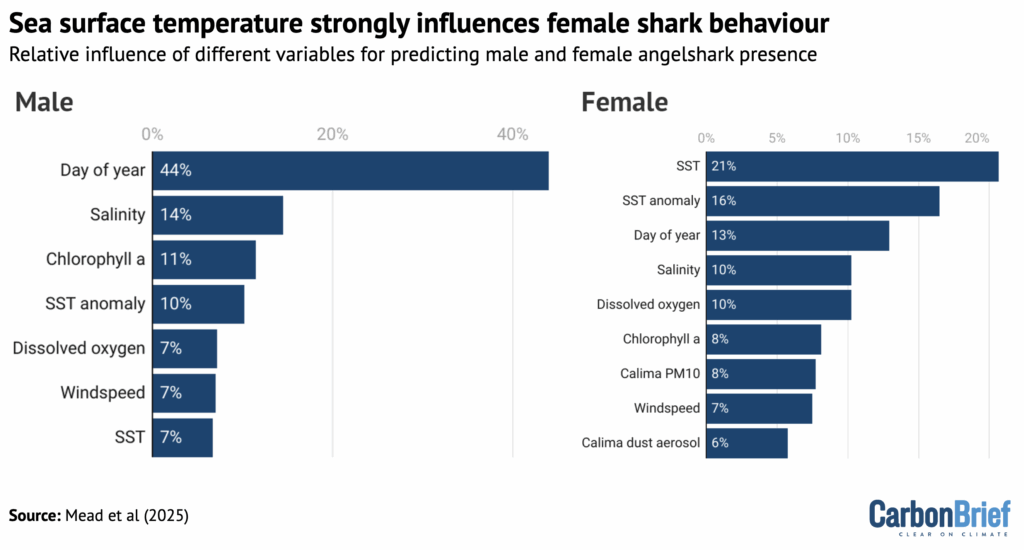
The “crux” of the study, according to Jacoby, is that in 2022 – when peak SSTs were higher and those conditions lasted longer – female angelshark numbers were “consistently low”. He tells Carbon Brief:
“The fact that there was this significant warming event in the north-east Atlantic was opportunistic from a research perspective at least, because it provided a natural experiment in which to directly compare behaviour under ‘normal’ versus ‘extreme’ conditions.”
This “marked absence” was especially noticeable during the angelshark breeding season in mid-to-late autumn, the data shows. In contrast, the behaviour of the male sharks did not change.
The charts below illustrate how, in 2022, daily counts of female angelsharks (orange bars in the middle panel) dropped in the unusually warm conditions, while daily counts of male angelsharks (turquoise bars in the bottom panel) remained consistent with previous years.
In the top panel, orange regions indicate periods in which SSTs are between 20.7C and 22.5C and red regions show periods of SSTs above 22.5C.
According to the authors, the presence of female sharks in the study site decreases “rapidly” at SSTs above 20.7C, while the “probability of female presence” is below zero above around 22.5C.
The dotted line at 19.6C shows the temperature of peak female angelshark presence.
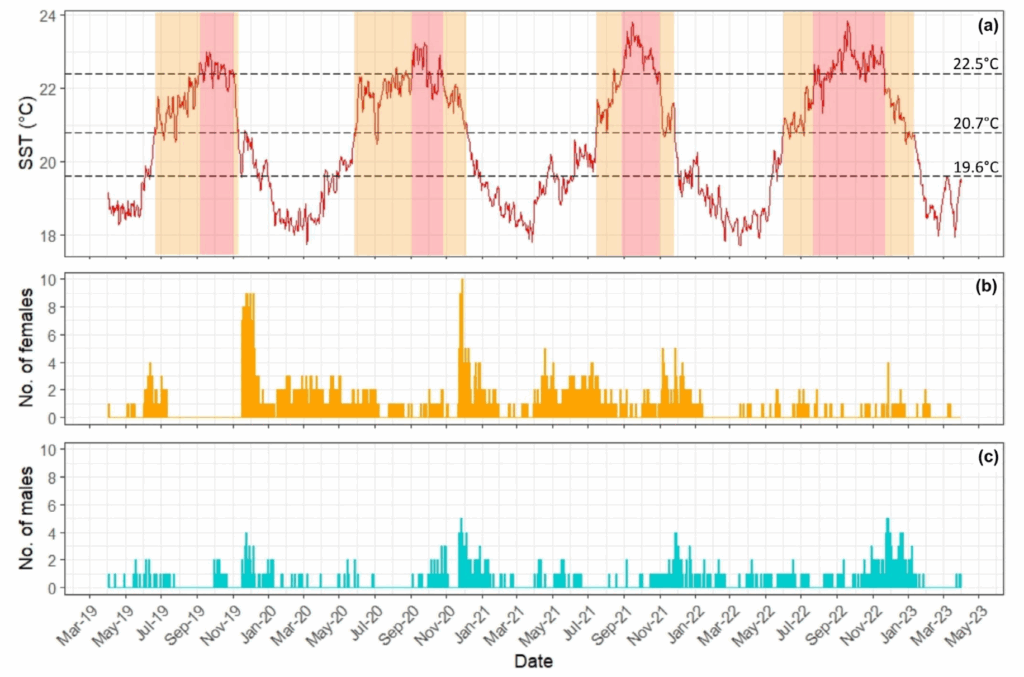
The researchers say their findings “strongly” indicate that the low numbers of females during the breeding season in 2022 were linked to the “thermal extremes” that year.
They point to an “upward trend” in peak temperatures and longer duration of hotter periods in their dataset, noting that the number of days where SSTs reached 22.5C more than doubled over the study period.
As a result, the authors identify 22.5C as the “possible upper thermal threshold” for female angelsharks – meaning that the animals will not move into an area at this point.
They warn that regular temperatures of 22.5C could “disrupt” the timing of “key biological events”, such as breeding.
The “unusual” findings, recorded as “disrupted” thermal cues, may be a “window into future climate change impacts”, suggest the authors.
Conservation measures
The authors highlight the need to prioritise further “species-specific” studies that incorporate “real-time environmental and behavioural data” and explore climate impacts by sex.
Improving scientific understanding and prediction of how marine species and ecosystems respond to climate change are “urgent priorities”, they say.
Jacoby adds:
“Angelsharks [are among] the most threatened fishes in the world. Because they rely on the ocean floor to rest and hunt, they are extremely attuned to their local environment. [Ocean warming] could lead to the [local extinction] of this species from the archipelago in a very worst case due to the fact that they are already at their thermal extreme in this location…
“We still don’t really know how warming could impact the complex web of interactions within these coastal ecosystems. It is so hard to engage with a problem if you can’t see it for yourself.”
Dr Hollie Booth is a postdoctoral researcher in the department of biology at the University of Oxford and was not involved in the study. She tells Carbon Brief that although the negative impacts of climate change are “concerning”, overfishing remains “the greatest direct threat” to angelshark populations.
She adds:
“It is good to see empirical evidence of the impacts of climate change on threatened marine species. [The study] indicates how we need to make sure that contributors to climate change are also held accountable for mitigating [these] impacts.”
The post Endangered angelshark faces ‘inhospitable’ breeding sites as ocean warms appeared first on Carbon Brief.
Endangered angelshark faces ‘inhospitable’ breeding sites as ocean warms
-
Climate Change2 years ago
Spanish-language misinformation on renewable energy spreads online, report shows
-
Climate Change Videos2 years ago
The toxic gas flares fuelling Nigeria’s climate change – BBC News
-

 Greenhouse Gases1 year ago
Greenhouse Gases1 year ago嘉宾来稿:满足中国增长的用电需求 光伏加储能“比新建煤电更实惠”
-

 Climate Change1 year ago
Climate Change1 year ago嘉宾来稿:满足中国增长的用电需求 光伏加储能“比新建煤电更实惠”
-

 Carbon Footprint1 year ago
Carbon Footprint1 year agoUS SEC’s Climate Disclosure Rules Spur Renewed Interest in Carbon Credits
-
Climate Change2 years ago
Why airlines are perfect targets for anti-greenwashing legal action
-
Climate Change Videos2 years ago
The toxic gas flares fuelling Nigeria’s climate change – BBC News
-
Climate Change2 years ago
Some firms unaware of England’s new single-use plastic ban




